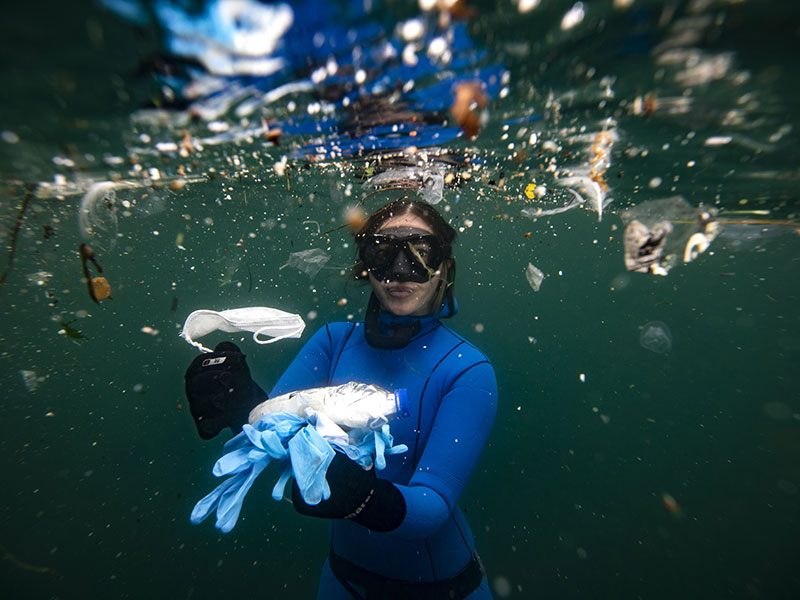The events that rattled the world
The Fukushima power plant disaster is an event that will live in the memory forever, and cost a fortune to recover from
The Fukushima power plant disaster is an event that will live in the memory forever, and cost a fortune to recover from
The crisis unfolding around the Fukushima Daiichi nuclear power plant is a narrative which many believe is inconspicuously drawing attention away from the human loss and suffering. A U.S. journalist said recently: “If it bleeds it leads, but if it radiates it fascinates.” This demonstrates, albeit a little bluntly, that the threat of a nuclear catastrophe has been the gravest concern to people worldwide closely monitoring the status of Fukushima’s nuclear reactors. As the situation continues to remain serious at the plant, despite heroic efforts to regain control and renew confidence in the industry, many have begun to wonder what impact the events have had internationally and how they will affect the nuclear power industry globally.
Day 1- March 11
At 14:46 local time an earthquake of magnitude 8.9 struck off the north-east coast of Japan, about 400 km from Tokyo, at a depth of around 24km. Fukushima Daiichi and Daini power plants suffer catastrophic and critical damage.
Fukushima uses a General Electric boiling water reactor design which operates at 285°C and produces electricity by boiling water, spinning a turbine with the generated steam. The process involves nuclear fuel, in the form of uranium oxide, heating water until it boils and creates steam, which then drives the turbines to create electricity. The procedure is complete when the steam is subsequently cooled and condensed back to water, which is then returned to be heated by the nuclear fuel.
The reactor’s containment unit, an airtight structure made of concrete and steel, holds the pressure vessel, pumps and pipes that contain the cooling water. Its sole purpose is to ceaselessly achieve a complete core meltdown. This is further supported by a solid, concrete composition which is dispensed around the containment unit as a secondary, additional control. Together the containment units are housed within the reactor building which is a shell designed to protect the core from damage. It was this exterior shell that suffered damage, bringing about the reactor explosions.
Press releases published on the TEPCO website and reports by the local media showed the Fukushima Daiichi power plant was not constructed to withstand an 8.9 strength earthquake, especially if directly followed by a larger than expected tsunami. Only moments after the earthquake hit an automatic tripping occurred which shut down nuclear reactor units 1, 2 and 3 immediately. Units 4, 5 and 6 had been shut down beforehand for outages. The shutdown caused loss of offsite power and the damage of the reactors’ exterior power supply triggers the first emergency system in place. The backing systems of the reactor, which continued to work the cooling pumps, are calculated and deliberate in their reaction when dealing with this sort of calamity. Besides, given that the power plant had tripped it could no longer generate electricity by itself. The plants protective seawall, which was designed to defend it from a tsunami of just under six metres, took a lashing by a 14 metre high wave that crippled the reactors at around 15:46 local time.
According to the updates from TEPCO, for around an hour the emergency diesel power generators fired up and supplied the electricity required for the core cooling systems, until the generators stopped working due to flooding. With the diesel generators flooded, the next crisis measure is activated successfully as the operators switch to emergency battery power to chill its core. The high∞pressure coolant injection system and the steam operated reactor core isolation structure delivered cooling to units 1, 2 and 3. Meanwhile, the seriousness of the situation requires further safety measures, especially for workers at the nuclear power plant, and an evacuation order is issued for any person in the immediate radius of 3 km of the Fukushima Daiichi power plant.
Day 2- March 12
The emergency backup battery for the high pressure core flooding system within reactor 3, which lasted eight hours, is depleted. The ability to cool the reactors of units 1, 2 and 3 is significantly reduced which causes the pressure in the primary containment to increase. Although a risk is associated with the release of pressure TEPCO makes the decision to discharge some vapour, which contains some radioactive material, into the air to release pressure within reactor unit 1. The evacuation of residents within a 10km radius of the power plant begins around 15:30 pm local time.
It is only a few minutes after the commencement of the evacuation when TEPCO reports cameras in the Daiichi plant have picked up a vast hydrogen explosion in unit 1 which destroys the outer structure of the building where the spent fuel pool is housed. As the exterior structure collapses the unit 1 spent fuel pool is exposed to the atmosphere. The decision is taken to expand the evacuation zone to 20 km around Fukushima Daiichi. Workers begin to infuse sea water inside the pressure vessel of the reactors through the fire services’ array of mobile trucks.
The possibility of a partial core meltdown at unit 3 becomes increasingly likely, ie if cooling is not restored the core will ultimately melt. However, as the key aim at that stage was to vent reactors 1 and 3 to release built∞up pressure, water and boric acid was used to cool and control further nuclear reactions. Although unit 2 contained a lower than usual water level with a high pressure inside the containment vessel, it was considered to be stable.
Day 4- March 14
Eleven people are injured when a hydrogen explosion occurs at the reactor building for unit 3, causing significant damage to its exterior structure and exposing its fuel pool to the atmosphere. The water level for the reactors of units 1, 2 and 3 is beneath the top of active fuel and fuel damage is suspected in all units, however, containments at all three units remain intact. Autorité de sûreté nucléaire, the French nuclear safety authority, considers the accident serious, as high as a 6 on the International Nuclear and Radiological Event Scale (INES). Operators continue to expel steam occasionally to control the underlying pressure of the vessel and containment.
Day 5- March 15
Reports of a fire and damage to the top level reactor in unit 4 emerge followed by a hydrogen explosion within the reactor building of unit 2 and 4. The danger of water boiling in the unit 4 spent fuel pool is imminent.
Day 6- March 16
Water inside the spent fuel pool of unit 3 reactor building begins to boil while white smoke starts rising, causing TEPCO to evacuate its workers due to mounting levels of radiation, reaching up to 1 Sv/h. This is usually the maximum acceptable yearly dose for the public from any manmade facility.
Day 7- March 17
Helicopters drop sea water throughout the morning on the spent fuel pools of units 3 and 4 until the latter’s spent fuel pool is filled with water and none of the fuel rods are exposed. Simultaneously construction workers start to supply a working external electrical power source to all six units.
Week 2-3 (March 18–31)
Over the next few days fire services continue to spray sea water into the unit 3 spent fuel pool and 40 tonnes of seawater has been inserted into the unit 2 spent fuel pool, which is powered by offsite sources. For the first time reports start flooding in that milk and spinach from surrounding areas has radiation levels that surpass Japanese standards. Tap water in Fukushima shows higher than authorised levels of radioactive iodine while higher than usual levels of radioactive iodine and caesium is found in Tokyo’s water supplies. An instruction is issued by the Japanese government for the suspension of shipment of certain foods. A few days’ later tests of sea water near units 1, 2, 3 and 4 pick up levels of radioactive iodine and caesium that go beyond regulatory perimeters. Core cooling of the unit one reactor becomes necessary on day 14 when it reaches 400°C, 100°C above its sanctioned design value. Three workers get exposed to elevated levels of radiation while two others receive hospital treatment due to burns from increased level beta radiation. There are constant efforts to cool the reactor cores and now fresh water is used instead. Temperatures are brought down to a controllable 204°C. However, water contaminated with high radioactivity has leaked to the workspace while water found in the turbine buildings of units 1, 2 and 3 contains radioactive substances, as high as 1,000 mSv/h in unit 2 and 750 mSv/h in unit 3. Examination of numerous water samples taken from the turbine building sub drains on March 30 find detectable and traceable levels of fission products.
Week 4-5 (April 1-12)
Fresh water is injected into the spent fuel pool at all units. Radiation levels exceeding 1,000 mSv/h are found near unit 2 in the pit where supply cables are stored and a 20cm fracture is found on the side of a cavity where water is flowing out into the sea. Works begin immediately to close the cavity in order to reduce additional outflow of water into the environment and succeed only three days later. TEPCO discharges around 11.5 tonnes of water with small levels of radioactivity into the sea to allow more highly contaminated water to be collected in other sites at the plant. On April 7, 26 days after the first earthquake, an aftershock quake of 7.1 occurs but the impact to works at the plant is generally minimal. Over the next few days over 1,320 tonnes of low∞level contaminated water is discharged from the sub drains at unit 5 and 6 in preparation for the releasing of around 11,500 tonnes of faintly contaminated water from the site in order to permit storage of more highly contaminated water that will be used to cool the reactors. On April 12 the government decides to raise the INES grade of the accident to seven due to the high release of radioactive waste.
Week 6-7 (April 12 – 26)
Samples taken from sea water around the power plant contain levels of radioactive material higher than regulatory limits allow and efforts are made to minimise the release of radioactive material from the site. On April 15, Japan’s Nuclear and Industrial Safety Agency (NISA) instructs TEPCO to increase the number or sample points and to take marine samples in order to better characterise and assess the release of radioactive material. The centralised radioactive waste treatment facility to process the contaminated water gathered on site is ready and transfer begins on 19 April 2011. Radiation readings from the unit 1 and 3 reactor buildings are undertaken through the usage of remote controlled robots. The spent fuel pool cooling continues at units 1 to 4 by injecting water directly into the pools with electrical pumps. Cooling of the reactors at units 1 to 3 is ongoing and efforts to manage the spread of contamination from the site with steel plates installed at the unit 2 intake structure.
Ongoing efforts crews keep on cooling the spent fuel pools at all units by injecting water directly into the pools with electrical pumps and by spraying water from concrete pumping trucks. In May a ventilation system was set up to improve the working surroundings within the reactor building of unit 1.
The airlocks are opened on May 9 and measurements of the air dose rate confirm that there is no radiation impact to the outside environment. TEPCO announced a meltdown in one of its reactors while seawater samples near another reactor showed levels of radioactive caesium at 18,000 times the legal limit. An estimated 90,000 tons of radioactive water remains from the pumping of water to cool reactors and the dilemma is mounting by the day, as the volume of contaminated water keeps increasing. French nuclear engineering company Areva and Tepco sign a contract and start treating the array of radioactive water in June.
Post Fukushima
The situation created by the crippled Fukushima power plant has raised further concerns about the safety and viability of nuclear energy. So, what will the disaster mean for the nuclear power industry? Events at Fukushima have shown that even if the situation does not deteriorate any further the damage has already been done. Fukushima has demoralised the industry’s dependability as shockwaves have rippled through the finance and energy communities raising questions about whether nuclear is worth this hassle, or if cheaper and safer alternatives should now be considered.
A question of finance
High profile nuclear utility companies, such as the South Texas Project majority shareholder NRG, have started to rethink matters. The company withdrew from the project in April writing down $481m investment and excluding any further investment. CEO David Crane said: “This tragic nuclear incident has introduced multiple uncertainties around new nuclear development in the United States which have had the effect of dramatically reducing the probability that STP 3 and 4 can be successfully developed in a timely and prompt fashion.”
Panic among utilities companies also emerged when it became clear how many billions in compensation will have to be paid out to victims of nuclear accidents such as this one. Only recently the Japanese government endorsed a scheme to help TEPCO compensate victims of the disaster at the tsunami-stricken nuclear power plant and save it from financial collapse. Japan’s prime minister, Naoto Kan, approved the plan to create a new body to facilitate funds to utilities companies expecting to pay nuclear accident compensation claims to victims. It is said that a government committee will for a brief period take over the control of management at TEPCO to monitor its restructuring measures. TEPCO’s balance sheet has been wiped out and compensation claims are estimated to reach trillions of yen, primarily from Fukushima residents living in the vicinity of the power plant.
Alternatives to nuclear energy
The recently published annual Nuclear Industry Status Report has highlighted that advanced technology and mass production are progressively making nuclear powers’ renewable competitors cheaper. Wind turbines for instance beat new nuclear costs by two to threefold and solar power by half the report showed. It was noted that prices are gradually decreasing, with a standard crystalline∞silicon photovoltaic module costing $4.20 per peak watt in 2009 when today it is $1.70. Forward pricing has shown that it will be $1.35 by the end of 2011 and $1.00 by mid∞2012. So it comes as no surprise to many that micro power generated around 90 percent of the world’s new electricity in 2008.
Businesses according to the report have over the past few years invested more in renewable energy than in nuclear power. Last year all renewable energy, except for large hydro, received $151bn in private investment globally and exceeded nuclear power’s total global installed capacity. Nuclear power in comparison received no investment at all.
Even before the world was hit by the Japanese disaster, the nuclear industry has been slowly acknowledging that renewables are progressively becoming a realistic competitor. Some continue to claim that wind and solar power’s inconsistency disqualify the growing renewable power sources as an unpredictable opponent. However, the report shows that the reverse is actually correct. It provides the reader with an insight of basic quantitative and qualitative facts regarding nuclear power plants in operation, under construction, and in planning phases throughout the world. Simultaneously it assesses the economic performance of past and current nuclear projects and comparing their development to that of leading renewable energy sources and their accomplishments.
The all∞embracing research offers a country∞by∞country breakdown of nuclear programmes around the world and shows that even before the Fukushima calamity began, the swiftly aging nuclear industry has been powerless at stopping the demur of nuclear energy as it can’t compete with the pace set by renewables. According to the research, renewable facility additions have been steadily outpacing nuclear start∞ups for the past 15 years. Last year the capacity of wind turbines, biomass and waste-to-energy plants, and solar power reached a combined 381 GW, beating the 375 GW produced by nuclear energy.
In April at the last count 437 nuclear reactors were operational worldwide, seven less than a decade earlier. There are 64 reactors under construction in 14 countries according to the International Atomic Energy Agency (IAEA) compared to 233 at the beginning of the 1980s. Within Europe there were 143 operational reactors, down from a historical high of 177 units in 1989.
Nature’s quake∞tsunami double strike is an exceptionally unusual occurrence, but many have queried the wisdom of constructing nuclear power plants in highly active seismic areas.
Only time will show how the current situation will impact on the image of nuclear power. If the catastrophic meltdown is contained and the reactors are successfully shut down with no further release of radiation, then the nuclear power industry will declare that even when they faced the most awful natural disaster, they got through it almost unharmed.
Countries such as Germany and India have started reviewing their nuclear precautions and available options in light of what has happened in Japan. Overall Fukushima won’t lead to the end of the nuclear energy industry ∞ too much is already invested worlwide in the industry for that to be the case. However, the post∞Fukushima circumstances add to the international economic crisis and are exacerbating the struggle that proponents of nuclear energy have to deal with.













